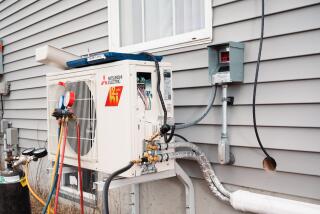When Less Is More (Profit) : Productivity: Cutting energy use would trim costs, making U.S. firms more competitive. It would also create jobs and clean up the air.
- Share via
If there were one investment that would make American products more competitive internationally, help clean up Los Angeles’ renowned smog and reduce the cost of complying with environmental laws, wouldn’t you think that the nation and business would plop down the currency?
The investment we’re talking about is energy efficiency, known as conservation in the days of Jimmy Carter. Hardly the sexiest topic in the world--unless you like warm sweaters--yet such investments seem to be a tonic for just about all of U.S. industry’s woes.
For manufacturers, the advantage of greater energy efficiency is quite clear: Production costs would drop. But despite this logical method of gaining ground on international competitors, the U.S. government and much of industry are looking the other way.
Consider this: The United States consumes 75% more energy per dollar of gross national product than France and Japan do. But U.S. research and development support for energy efficiency is less than these two countries’ and less than in the United Kingdom and West Germany as well.
The greatest sin associated with our past preoccupation with fossil fuels is that we are losing 70% to 80% of their potential energy production because of inefficient combustion processes that create pollution. Cogeneration--a term coined in the 1880s that refers to the generation of two types of energy from one fuel source--was once the norm in this country.
However, with the discovery of abundant oil, industry began to pay less attention to efficiency. Of the 16 million barrels of oil this thirsty nation consumes every day, more than 85% is used in monogeneration systems functioning at 20% to 40% efficiency.
According to Robert Healy, author of “America’s Industrial Future: An Environmental Perspective,” American industries are falling behind because they won’t acknowledge the correlation between low profitability and failure to invest in environmental upgrades such as greater efficiency. Firms doing poorly are typically those that disdain regulation, lobby for a relaxing of standards and are reluctant to invest in new energy conservation equipment.
The steel industry, which had an average rate of profit of 7.05% throughout the 1970s, exemplifies this shortsightedness. On the other hand, the domestic paper industry, whose profitability ratio stands at 12.3%, has by and large upgraded its processes to modern environmental standards. These investments are paying off. The paper industry uses 15% less energy than it did in 1972, while it has increased production by more than 17%.
Too much of American industry, nevertheless, is characterized by old, inefficient processes. The electrolytic process by which we make aluminum has changed little since it was introduced in 1886. Even when industrial innovations occur, it takes too long for them to be widely adopted. A researcher who analyzed nine different petroleum refining processes discovered that it took an average of 13 years for a new method to become standard practice.
Lawrence Berkeley Laboratory says the benefits of improved industrial and residential energy use would include $100 million freed up annually for capital investments in U.S. industry. The poor would have more jobs and lower energy bills, and carbon dioxide and other air pollutants would be greatly reduced. A focus on energy efficiency and market incentives would also be a much cheaper way to clean up Los Angeles’ smog than the old-fashioned command-and-control dictums imposed by the South Coast Air Quality Management District.
Roughly 80% of the air pollutants that combine to produce smog are the result of making or consuming energy. The California Energy Commission estimates that California manufacturers’ energy costs are 45% higher than the national average.
These two statistics should make the wise business executive with both a social conscience and a sharp eye on the books sit up and realize that investing in energy efficiency is the only logical thing to do. Along with helping the bottom line, such investments are the cheapest way to earn both economic and environmental returns.
More to Read
Inside the business of entertainment
The Wide Shot brings you news, analysis and insights on everything from streaming wars to production — and what it all means for the future.
You may occasionally receive promotional content from the Los Angeles Times.








